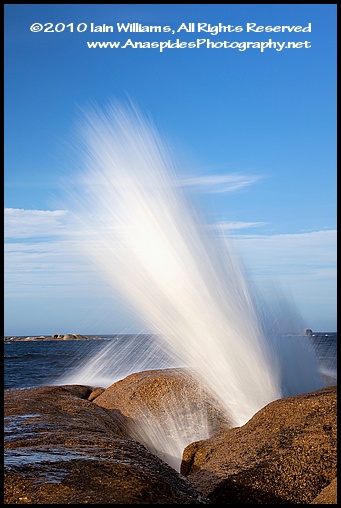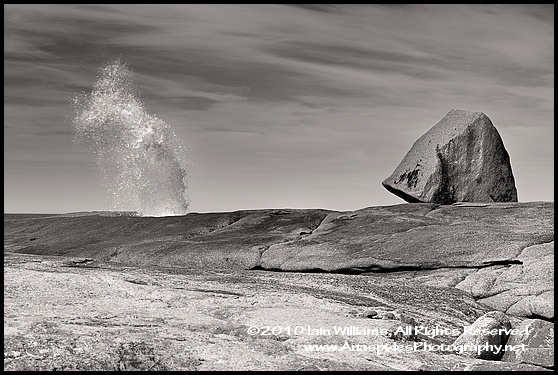Hunting Wild Tasmania Devils in the Night
 Friday, April 9, 2010 at 9:05PM
Friday, April 9, 2010 at 9:05PM 
Tasmania Devils (Sarcophilus harrissii ) are endemic to Tasmania, a small island state in Australia. Once common throughout forest areas, these nocturnal creatures are declining in numbers and have been listed on the IUCN Red List as endangered. The reason for the decline and IUCN listing is the development of a viral disease called Facial Tumour Disease. The disease, which is still being investigated and mapped, spreads rapidly amongst devils as they fight and argue amongst themselves for mating privileges and when competing for food.
LEFT: A wild Tasmania Devil pauses and looks about for potential predators.
Natural History – A Few Facts
Devils are the largest marsupial carnivore, roughly weighing the same as a largish medium sized dog. They have excellent smell, can travel long distances in an evening in search of prey, and can eat 20 times their own body weight in one sitting. They primarily feed on carrion, although live prey is often taken. Their life span in the wild for roughly 5 years and they become sexual mature at 2-3 years. Although devils appear vicious looking they are not; I’ve had wild devils sniffing at my boots and playing with my tripod legs! Adding to their perceived vicious reputation is their loud cry which is very unnerving when heard on a dark night, and their rather poor table manners – devils argue over food and often have short-lived fighting arguments which can be quite intense and very loud.
Photographing Wild Devils- Equipment
Photographing wild Tasmanian Devils is not easy! First you have to find them, and then they have to be receptive to you being in their space. Further,  shooting at night with flash and fixed light is not the easiest of activities as any budding photographer will attest to.
shooting at night with flash and fixed light is not the easiest of activities as any budding photographer will attest to.
I use an assortment of equipment to photograph devil which chnages depending upon the environmental situation. Usually I have two industrial style spotlights set up either side of the carcass. It’s important to try and disguise the lights as much as possible and usually I’ll hide them in the bush. The purpose of the lights is to allow the camera to acquire a focus lock easily on an approaching devil. I’ve discovered through trail and error that some devils don’t mind the lights at all, while others shy away from them – it’s a personal devil thing.
LEFT: A Tasmanian Devils rips open the carcass in a frenzy to eat as much as it can before other devils join in the feast.
I always use a tripod and usually use a 70-200 f2.8 zoom lens or a 300 f2.8 lens attached to a Canon 1Ds camera. I use two Canon 580 EX speedlights. One flash is mounted on a Wimberely flash bracket from the camera L-plate (main light) and the other flash (fill light) is mounted on a small tripod and set off to the side. I sync the speedlights using two pocket wizards. To ensure that the speedlights are pointing exactly at the devil and not pointing elsewhere, I use a small portable red laser light. The laser light ensures that the flash is pointing a exactly the place I want the artificial light directed. On occasion I also use a better beamer and/or flash snoot to help funnel the light and not expose the background too much. I always set the flashes to manual and rarely use ETTL.
Nocturnal photography of wild animals can be very hit and miss, especially when  you must maintain your position and be relatively quiet. Often if you relocate your position on the fly, and the devil is wary, it will run away and not return that night.
you must maintain your position and be relatively quiet. Often if you relocate your position on the fly, and the devil is wary, it will run away and not return that night.
LEFT: A Tasmania devil part way through it's dinner on carrion, stops and looks about before screaming out loud to warn other devils that he has first dibs on the food.
Establishing a Blind & Bait
I’ve spent quite a bit of time photographing devils in a number of locations and by far the best method is to establish a blind of some description; my latest blind was a hole in the ground covered with a military style camouflage net. On this particular night it was quite amusing, it rained filling the shell scape (a small hole) that I’d dug with water.  I can remember spending the night cold, wet and miserable until 3 devils came by to cheer me up.
I can remember spending the night cold, wet and miserable until 3 devils came by to cheer me up.
LEFT: A Tasmania Devil stands over carrion that has been securely staked to the ground.
There is no chance that you will photograph, let alone see a devil without setting bait. I usually collect road kill and then securely stake it to the ground in an opportune area. I then create a number of blood trails through the forest leading to the staked kill . A blind can be almost anything from a shell scrape in the ground with a net, to hiding amongst bracken. It’s important to reconnoiter the location of the blind as it must be downwind of the carcass. Devils have exceptional senses of smell, and they w ill smell you a long way off if your scent is blowing toward the carcass. I remember on one devil shoot the wind was blowing the wrong direction. I could see the devils in the distance circling the bait, but they would not approach closely. I decided to cover my clothes with the odour of dead wallaby, and this partly solved the problem, but they were still wary.
ill smell you a long way off if your scent is blowing toward the carcass. I remember on one devil shoot the wind was blowing the wrong direction. I could see the devils in the distance circling the bait, but they would not approach closely. I decided to cover my clothes with the odour of dead wallaby, and this partly solved the problem, but they were still wary.
LEFT: Tasmania Devil with Facial Tumour Disease (FTD) on face near jaw. In the last 12 months I have witnessed a steady increase of devils with FTD in this area.
Patience
Patience is a virtue with devil photography. Although devils are most active and hour after dusk and an hour before dawn, they can turn up at the kill at anytime during the evening. Often you must put in long hours of waiting for a devil to turn up – and then there is no guarantee that the devil will feed on the carcass. I’ve seen lots of devils appear, scout the location and then disappear into the night as quickly as they appeared!
Exciting Experience
I enjoy photographing all animals; however, there is something about devil photography that keeps me wanting to go back for more. Perhaps it’s having to be patient waiting for a devil to appear, or maybe it’s the work you have to do before you even see a wild devil. You have to establish a blind, find road kill, set the bait and then stay awake most of the evening; you also get VERY dirty and often are covered in odour and blood from the carcass. Certainly, the work before the shooting begins makes any images taken far more worthwhile.
I certainly get a “buzz” when, on a dark drizzly night, you see a white blaze in the darkness moving toward you! To have the privilege of observing the feeding habits of these amazing creatures is a wonderful experience, albeit a messy one.
If you’re interested in reading more about the plight of the Tasmanian Devil, navigate to the official “Save the Tasmania Devil” web page at http://tassiedevil.com.au/
To read a little more about the Tasmania Devil Task Force, click here.
To view short video of devils feeding that I filmed on a previous trip, click the multimedia tab in the menu bar above.
 Iain Williams
Iain Williams
FOLLOW UP: – MARCH 2011
Scientific study and results have identified that the disease was not caused by a virus or bacteria but an infectious line of cancer cells passed from one animal to the next by cell implantation, such as when they bite one another.
This breakthrough at the State Government’s Mt Pleasant Laboratory gave hope to devil researchers that they might be able to control the disease in the wild.
Officials have stated that this maybe a turning point in the investigation of the devastating disease and the breakthrough study has been noted by the global scientific community.









